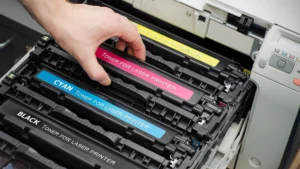Enzyme substrate may sound like a scientific term, but it offers a powerful way to understand printing and branding. The substrate you choose affects how your colors appear, how durable your pieces are, and how professional your brand looks across every location.
Keep reading to see why the right choices turn every print into a stronger statement for your brand.

Understanding Enzyme Substrate in Printing
In biology, an enzyme is a type of protein that speeds up chemical reactions without being used up itself. Each enzyme has an active site, a pocket shaped to fit only certain molecules. The molecule that fits into this site is called the substrate.
When the substrate binds to the enzyme, a reaction occurs, and a new product is formed. Then the enzyme is ready to repeat the process again and again.
Scientists often use two types of substrates when studying enzymes:
- Natural substrates – taken from plants or other sources. These are complex, but they can vary in quality from batch to batch. That makes results unpredictable.
- Synthetic substrates – created in labs to be more consistent. They offer stable quality, but sometimes they don’t dissolve well or behave perfectly in every test.
In printing, the substrate is the material you print on, such as paper, cardboard, plastic, fabric, or metal. Just like enzymes need the right substrate to work, your brand needs the right printing substrate to achieve the desired results.
- Consistency is critical: Just as synthetic substrates reduce variation, choosing a reliable printing substrate ensures your brand colors and finishes look the same across all locations.
- Durability matters: A poor-quality substrate in biology ruins the test. A poor-quality printing substrate makes your campaign materials fade, tear, or wear out too quickly.
- Availability is key: Scientists need a steady supply of the same substrate for accurate results. In marketing, you need a dependable material source so your business cards, banners, or packaging never vary in look or feel.
Enzyme science teaches us that the substrate sets the standard for results. For marketers, the substrate you choose for printing does the same. It defines how strong, consistent, and professional your brand looks in the real world.
Why Substrate Is Critical for Brand Consistency
Your brand’s colors, textures, and overall look are what people see every time they interact with your marketing materials. If those details change from one location to another, your audience starts to notice, and trust decreases.
Even if your design file is perfect, the wrong substrate can make your colors look dull, your images blurry, or your finishes uneven.
The impact shows up in several key areas:
- Color accuracy: Different substrates absorb ink or toner in different ways. On one material, your brand’s signature red might look vibrant. On the other hand, it may look faded or too dark. Using the right substrate helps keep your colors consistent across business cards, packaging, and displays.
- Finish and texture: Glossy paper feels different from matte paper. Cardboard feels different from fabric. The choice of substrate directly shapes how your brand is experienced: smooth, rough, premium, or cheap.
- Multiple locations: Large organizations often print marketing materials in different regions or with different vendors. If each vendor uses a slightly different substrate, your brochures in New York might not match the ones in Los Angeles. That breaks brand consistency.
By choosing the right substrate and sticking with it, you make sure your brand looks reliable and professional, no matter where your materials are printed or displayed.
Common Types of Printing Substrates
Different materials offer unique strengths, finishes, and uses. Below are some of the most widely used substrates in marketing and branding.
- Paper – The most common substrate, available in glossy, matte, recycled, coated, or uncoated finishes. Good for brochures, flyers, business cards, posters.
- Cardboard / Paperboard – Thicker and sturdier than regular paper and often used for packaging, displays, and product boxes.
- Plastic (PVC, vinyl, polyester, etc.) – Durable, waterproof, and resistant to wear. Ideal for banners, outdoor signs, ID cards, or promotional materials.
- Fabric / Textiles – Includes cotton, polyester, canvas, or blends. They are used for apparel printing, branded bags, trade show displays, and flags.
- Metal – Strong and long-lasting, with a sleek finish and used for signage, plaques, nameplates, or specialty products.
- Glass / Ceramics – Specialty substrates often used for branded items like mugs, bottles, or decorative pieces.
- Wood / Specialty Materials – Less common, but can give a rustic or premium feel. Often used for high-end branding or custom décor pieces.
Each option comes with trade-offs, and the choice you make has direct consequences for your business.
Business Impact of Substrate Decisions
Substrate choices affect how much you spend, how customers see your brand, and how well your marketing performs. A wrong choice creates waste and higher costs, while the right choice adds value and trust.
- Cost savings: If a substrate causes colors to print poorly or finishes to wear out quickly, you may need to reprint. That means more time, more money, and more materials wasted. Choosing a stable, high-quality substrate reduces these risks and lowers overall costs.
- Durability: Durable substrates protect your investment. Posters that fade outdoors or packaging that tears too easily reflect poorly on your brand. Stronger materials last longer, helping your campaigns stay effective over time.
- Customer perception: People often judge a brand by how its materials feel in their hands. A flimsy brochure suggests cheapness. A sturdy, well-finished one suggests professionalism and care. The substrate helps shape that first impression.
- Return on investment (ROI): When your materials look sharp, last longer, and deliver a consistent brand message, your campaigns work harder for you. This translates into better visibility, stronger engagement, and more value from every marketing dollar spent.
These impacts clearly show why it’s worth taking a closer look at how to select the best substrate for your brand.
Choosing the Right Substrate for Your Brand
Now that you understand how substrates shape quality, durability, and consistency, the next step is choosing the right one for your brand. The choice depends on what you need your materials to do and how you want your audience to feel when they see or touch them.
- Match the material to the message: A luxury brand should avoid flimsy paper, while a brand that values sustainability might use recycled stock. The substrate needs to support the story you want to tell.
- Consider the conditions: Materials used outdoors need weather resistance. Packaging for shipping needs strength. Brochures for trade shows should be light but durable.
- Balance quality and budget: High-end substrates may cost more upfront, but they often reduce waste and last longer. Over time, this can save money and improve results.
- Work with trusted suppliers: Consistency comes from using reliable sources and partners. That way, every print run delivers the same look and feel, no matter where it’s produced.
Selecting the right substrate is a strategic decision that protects your brand’s image and ensures your campaigns succeed.
The Printery can guide you through the options, recommend the best substrates for your goals, and ensure your brand looks professional and consistent every time.




